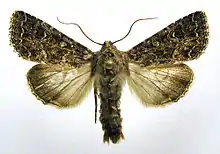| Confused | |
|---|---|
 | |
| Scientific classification | |
| Domain: | Eukaryota |
| Kingdom: | Animalia |
| Phylum: | Arthropoda |
| Class: | Insecta |
| Order: | Lepidoptera |
| Superfamily: | Noctuoidea |
| Family: | Noctuidae |
| Genus: | Apamea |
| Species: | A. furva |
| Binomial name | |
| Apamea furva (Denis & Schiffermüller, 1775) | |
| Synonyms | |
| |
Apamea furva, the confused, is a moth of the family Noctuidae. The species was first described by Michael Denis and Ignaz Schiffermüller in 1775. It is found throughout Europe. In southwestern Europe it is primarily montane. It is found as far north as the Arctic Circle. From Europe its range extends to Siberia, Turkey, Iran, Kyrgyzstan, Mongolia and Xinjiang in China.
The population in Great Britain and Ireland is sometimes treated as a subspecies, Apamea furva britannica.
The wingspan is 34–42 mm. Forewing varying from brownish to blackish fuscous, more or less dusted with grey or whitish scales, especially along the costa and inner margin and along the veins; lines conversely edged with pale; claviform stigma black-edged, or filled in with black; orbicular grey, with pale ring and black outline, often obscure; reniform always whiter, especially on outer edge; submarginal line whitish, waved, always preceded by distinct black wedge-shaped marks; the brown fringe finely cut by pale dashes; hindwing smoky grey, the terminal half smoky fuscous; veins and cellspot darker; the blackish fuscous forms, still with paler dusting, are ab. freyeri [Boie] and infernalis Ev. the latter being the darker.[1] Apamea furva is difficult to certainly distinguish from its congener Apamea remissa (Hübner, 1809). See Townsend et al.[2]

Adults are on wing from July to August.
The larvae feed on the roots and stem bases of various grasses, including meadowgrasses, fescues, slimstem reedgrass, and wavy hairgrass.[3]
References
- ↑ Seitz, A. Ed., 1914 Die Großschmetterlinge der Erde, Verlag Alfred Kernen, Stuttgart Band 3: Abt. 1, Die Großschmetterlinge des palaearktischen Faunengebietes, Die palaearktischen eulenartigen Nachtfalter, 1914
- ↑ Martin C. Townsend, Jon Clifton and Brian Goodey (2010). British and Irish Moths: An Illustrated Guide to Selected Difficult Species. (covering the use of genitalia characters and other features) Butterfly Conservation.
- ↑ Robinson, Gaden S.; Ackery, Phillip R.; Kitching, Ian J.; Beccaloni, George W.; Hernández, Luis M. (2010). "Search the database - introduction and help". HOSTS - A Database of the World's Lepidopteran Hostplants. Natural History Museum, London.
External links
- Kimber, Ian. "73.165 BF2329 The Confused Apamea furva ([Denis & Schiffermüller], 1775)". UKMoths. Retrieved 28 June 2019.
- Savela, Markku. "Apamea furva (Denis & Schiffermüller, 1775)". Lepidoptera and Some Other Life Forms. Retrieved June 28, 2019. Taxonomy
- Moths of Northern Ireland
- Lepiforum e.V.
- De Vlinderstichting (in Dutch)